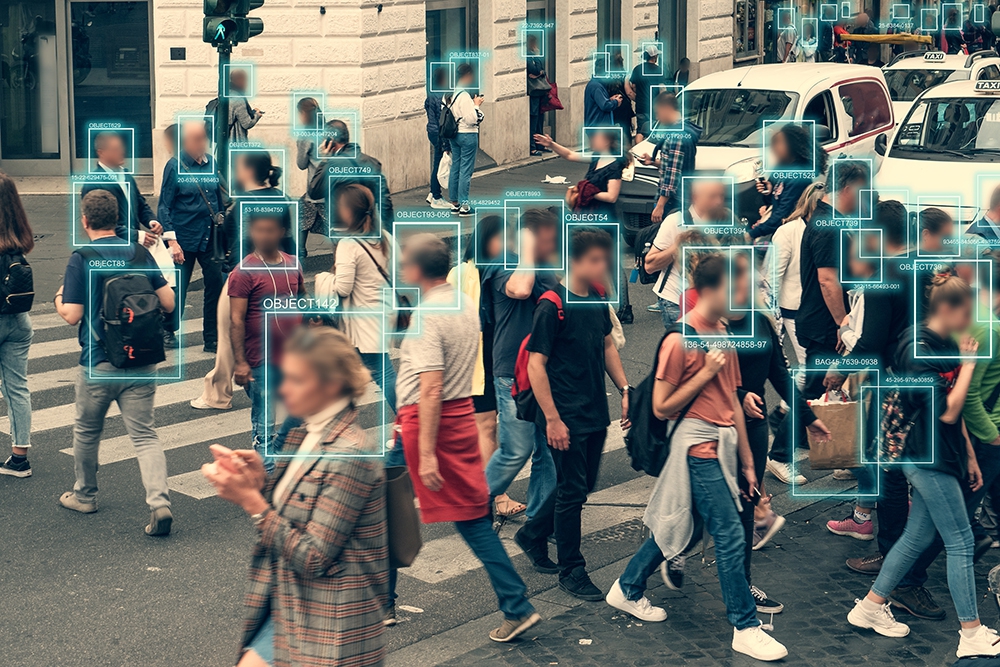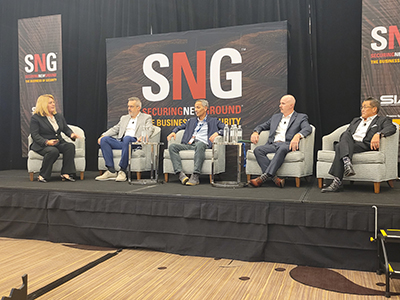'Power of AI': Use cases, security business implications Meaningful impact of artificial intelligence on security applications a focus during SIA’s executive conference

By Cory Harris, Editor
Updated 12:58 PM CST, Wed November 8, 2023

NEW YORK—Artificial intelligence (AI) is here to stay, and its current and future implications on the security space was addressed at the recent Securing New Ground (SNG) conference.
“What AI means for your business” was a session moderated by Tina D’Agostin, CEO of Alcatraz.ai, and featured panelists Hamish Dobson, CVP, product – enterprise physical security solutions, Motorola Solutions; Jumbi Edulbehram, global business development, smart cities and spaces, NIVIDIA; Matt Powell, managing director, Intelligent Security Systems (ISS); and Kurt Takahashi, CEO, Netwatch Group.
 D’Agostin noted at the top how AI was a hot topic throughout the conference. “All throughout the day we've been hearing about AI, and now we want to really unpack those use cases and talk about the implications and applications within our business,” she said.
D’Agostin noted at the top how AI was a hot topic throughout the conference. “All throughout the day we've been hearing about AI, and now we want to really unpack those use cases and talk about the implications and applications within our business,” she said.
Use Cases
D’Agostin started off by asking the panelists to talk about the use cases that they see in AI in physical security or in other industries that their companies extend into.
“We’re a user of AI, from the edge to the NVR [network video recorder] to the cloud, so we're processing millions and millions of video alarms every month, millions. And we utilize all different layers to help filter out all the noise,” Takahashi explained. “We could not succeed as a monitoring company without it. The mass amounts of data that’s coming in, and all those false alarms, you just couldn't stay in business if you didn't utilize it, so we're a user of it. We partner with many different AI companies, and it’s really the heart and soul of what we do because we couldn’t exist without it.”
Powell cited one of SIA’s annual Security Megatrends – eliminating industry boundaries – in explaining AI’s influence on use cases.
“That's where we see it a lot, whether it's intelligent transportation, we see it in a lot of manufacturing facilities for worker safety and labor safety, and people trying to really dial in their business to understand the business better,” he noted. “We're seeing the elimination of industry boundaries happen very rapidly as people look to our space, especially with all the cameras everywhere. The big question they're always asking is, what more can I do with this?
“So, we're driving our AI and augmented intelligence into those areas. When you start getting on the roadside or into a manufacturing facility, you start to get outside of what you would think is security. But also, when you look at workers compensation claims and fatalities and accidents and so forth, it's a different type of securing the environment.”
“Where do you even start?” Edulbehram asked. “We develop platforms for companies to make AI applications, and in my partner ecosystem right now - about 1,400 companies - they’re making applications for literally everything you can imagine – people, vehicles, faces, number plates, behaviors. There is also predictive analytics based not just on collecting the data, but analyzing all the metadata you collect about how people and things behave in particular spaces, so a lot of interesting applications there.
“People think about AI as something that you go out there and implement and collect some information, etc. There's a whole new area that's developing for companies to utilize to improve their own operations, for example, vehicle routing or helping service technicians or call center operations or even cybersecurity. There's literally AI in pretty much everything these days.”
Dobson added, “The power of AI is to really focus the attention of our security professionals on what is most relevant at any given instant in time, and then lean on the security professionals to assess the situation and determine the right course of action from a given set of influences, so that's where I start.”
AI Implementation
D’Agostin asked the panelists to highlight a recent AI implementation, detailing the use case, the problem solved, and the business outcomes that they drove.
“We released our first LPR [license plate recognition] analytic in 2003, and that kind of opened you up because you understand vehicles, you understand vehicle roadways, you understand everything that happens around the vehicle,” Powell explained. “We have a large tolling authority that we're doing a large deployment for, and being able to leverage what we traditionally think of as LPR - read the license plate, put it through a database and see if it comes back with some type of hit, whether it's criminal or some kind of AMBER Alert or something like that - they want more data coming through for the make and model, color and classification and traffic flow in the direction.
“AI is really taking this technology that has been around for a long time and starting to find these new applications to where we're not only able to give better data for traffic to be able to travel, but we're also able to give data for them to start looking at ways to prevent fatalities, why crashes happen and so forth. It's kind of taking that LPR - all the information that we have from it - and being able to repurpose it into that intelligent transportation system environment.”
Takahashi added, “A couple of years ago, we realized that we weren't going to be able to continue to scale by just people - adding more operators, more intervention specialists to the center. So, we went down a path to develop our own internal algorithm to just filter out the noise - trees, rain, trash, any of those types of things. We were relatively successful with it; we probably were able to affect, I'd say, 20 to 30 percent of those alerts.
“Then we realized that we needed to get something stronger, so we went out and evaluated several different companies, and we're now able to utilize all of them in different applications. So now that 20 to 30 percent is now like 40 to 50 percent.”
Dobson noted, “Cloud computing opened a new set of use cases because we can run huge, very accurate models that we weren't able to run on the edge before - things like firearm detection, you can imagine how hard that would be because it's quite a small object in a very large field of view. We've leaned on the ability to run models in the cloud to open those kinds of use cases.
“Probably the most broadly used analytic I've seen in our portfolio is something we call Appearance Search, which is an analytic that captures a profile of human or vehicle objects. You can right click on it and record a video and say, show me where this object came from before. You can take an investigative workflow which might have taken hours down to 30 seconds, and really brings it into the realm of a real-time tool, which I think is incredibly powerful.”
Macro Trends
The panelists delved into macro trends that are driving the use case for AI when talking with a partner, an integrator, or an end user.
“I think that the macro trends are everywhere they look, and they want the answer and they're going to find it somewhere, whether it's within our industry or outside,” Powell explained. “I think the macro trend that we see most is that the adoption of it, the marketing of it, everything is AI. Everybody's asking for it. Everybody wants to solve the business problem. They're just trying to figure out where they're going to get it and how do we position our industry to be that place that they come to.”
Takahashi added, “It’s all about appropriately applying the right technology for the right situation and really vetting out what those outcomes are that you’re trying to achieve, because no two AIs to me are the same. I think there's an industry full of amazing technology companies, but everybody does it a little different, right? So, you have to really, truly understand what the customer use case is, what the application is, what infrastructure is going to be aligned. All of that has to really be well thought through or else you're going to have a bad outcome.
“I think that is one of the concerns that I have with AI in general, because it's the big thing, and it's going to solve a lot of these issues that are driving customers to buy. It's just, can you apply the right technology to the right solution and implement it the right way? I think that's something that we all as practitioners need to be very cautious of - to make sure that we're very thoughtful about how we do it, when we do, and why we do it.”
“I think the proliferation of sensors of all types, whether they're driven by IoT or just the number of cameras, etc., is creating an avalanche of data,” Dobson added. There's a saying, ‘A wealth of data creates a poverty of attention,’ and that's exactly the challenge, and we can't solve that problem without AI. That's where AI shines, pulling insights and massive amounts of data.”
AI’s Future Impact
D’Agostin wrapped up the discussion by asking how AI will continue to impact the physical security space in the next two to three years.
“[It’s about] Learning systems that can ingest huge amounts of data and draw insights from that and change the way we think about situational awareness,” Dobson replied.
“It’s getting to a point where you don't have to necessarily preprogram what outcomes you want,” Edulbehram said. “You just invest everything and process all your data. Then, after the fact, you can go in and extract the intelligence you need for your business and the security.”
Powell made quite an analogy when comparing COVID to AI. “When we look at [Microsoft] Teams adoption, before COVID how many people were really utilizing Teams as heavily as we do in businesses now? If COVID brought us 10 years into the future, AI is bringing us 100 years into the future, and it's happening very quickly. We just have to embrace this rapidly so that we can be part of this revolution.”
Takahashi lauded the impact of AI in security, stating, “I think from us being in the technology space in security, the growth has just been so fast, and I think it can exponentially grow in the next few years, enabling us to do better things faster and really enjoy the ride.”
Comments